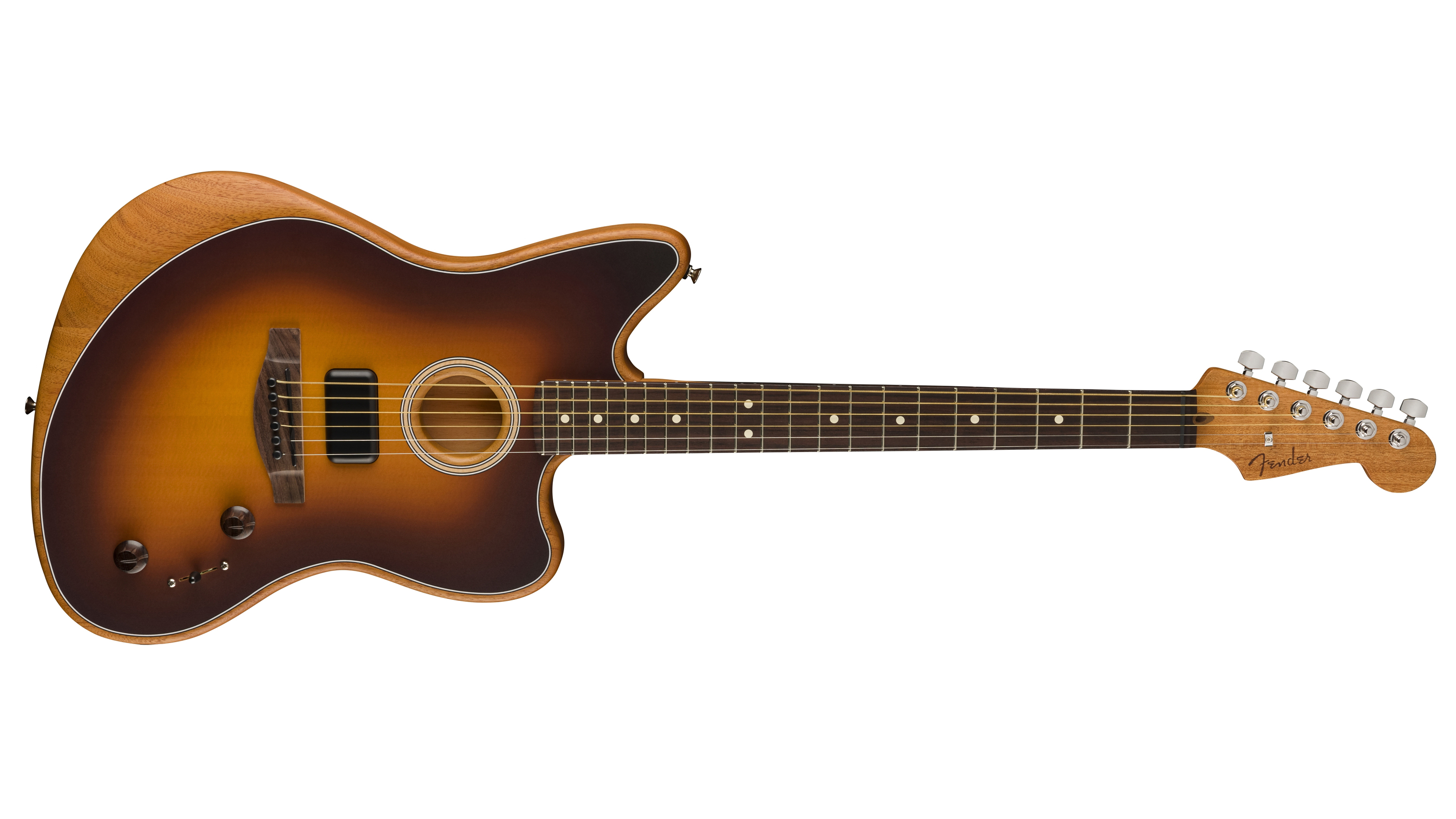MusicRadar Verdict
MusicRadar verdict: The Acoustasonic format remains an appealing and addictive instrument to have around. The standard here is high enough that players will mainly need to decide if the loss of the American model's body sensor and the tones it offers is worth the price difference for their needs.
Pros
- +
One of the most playable acoustic guitars we've tried
- +
• Excellent build quality
- +
Good results through a clean electric amp setup
Cons
- -
The US model is superior in sound and options compared
- -
Piezo tones in position two feel a bit inessential
MusicRadar's got your back
What is it?
Are Acoustasonics Fender's most divisive guitars? A cursory look across the internet's hives of forums and comment sections unearths vitriol and voraciousness; 'Two guitars for the price of three', 'The solution I've been waiting for', 'Jack of all trades, master of none'… But the truth is always more complicated than a soundbite, and our opinions in this review will be too. After several iterations we now have the second Mexican-made Player model and an opportunity to take stock three years after Fender lifted the veil on its electric / acoustic guitar hybrid.
It's still an ambitious guitar design, and with that comes more points for discussion and critique
It's still an ambitious guitar design, and with that comes more points for discussion and critique. Fender guitars are known for being modular with nearly every feature replaceable and therefore upgradeable. That's very much not the case here. In this sense it's certainly an acoustic guitar.
Fender are not the first to try the hybrid idea (and they even launched a different take on one back in 2010); acoustic structure, electric dimensions and neck; active electronics with a form of modelling that captures traditional tones. Originally launched with unfortunate timing just before the pandemic hit, the blueprint and message from Fender with the launch American Acoustasonic Telecaster suggested a stage solution. But again, the reality is more complicated – or should we say, more nuanced.
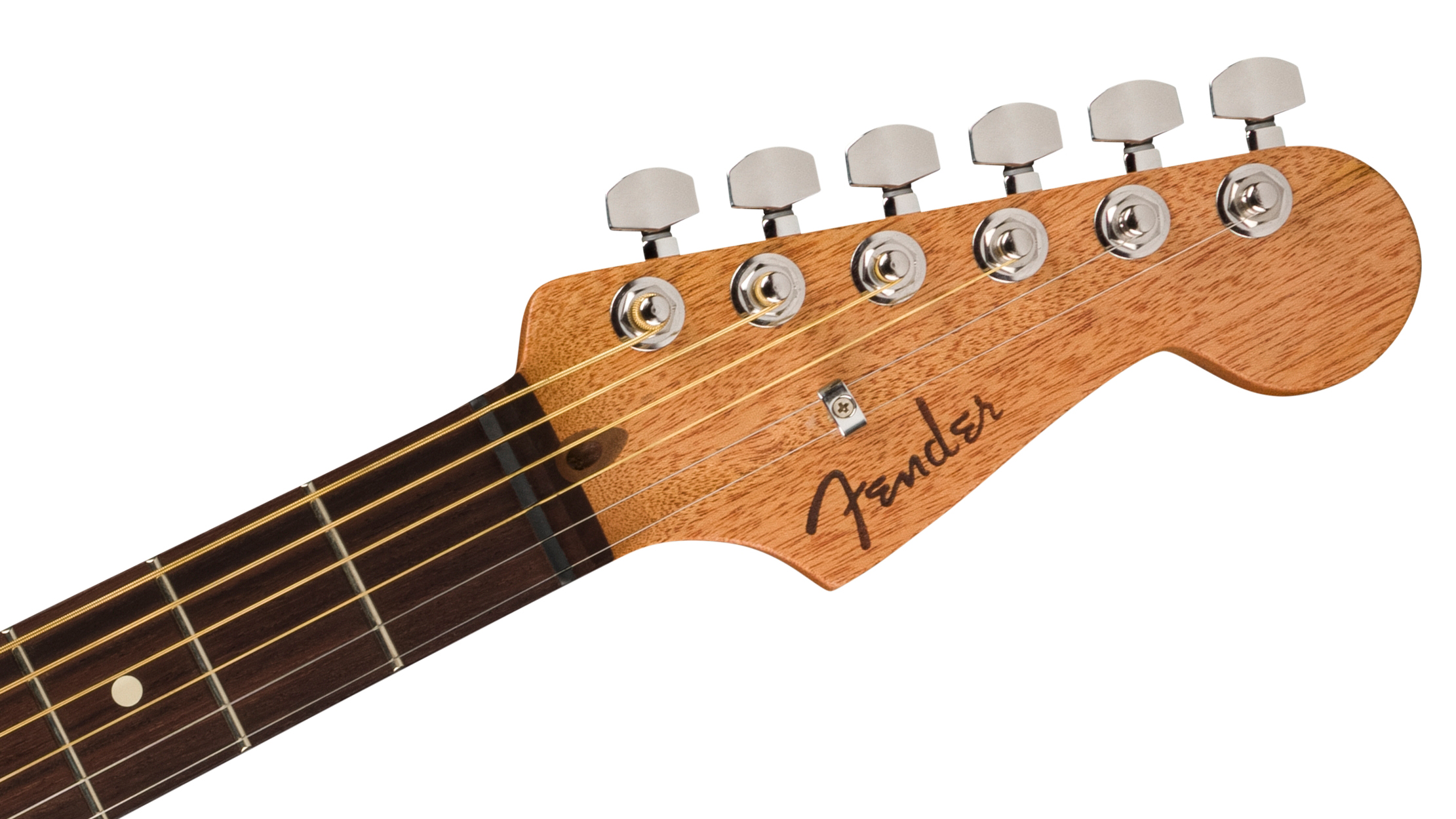
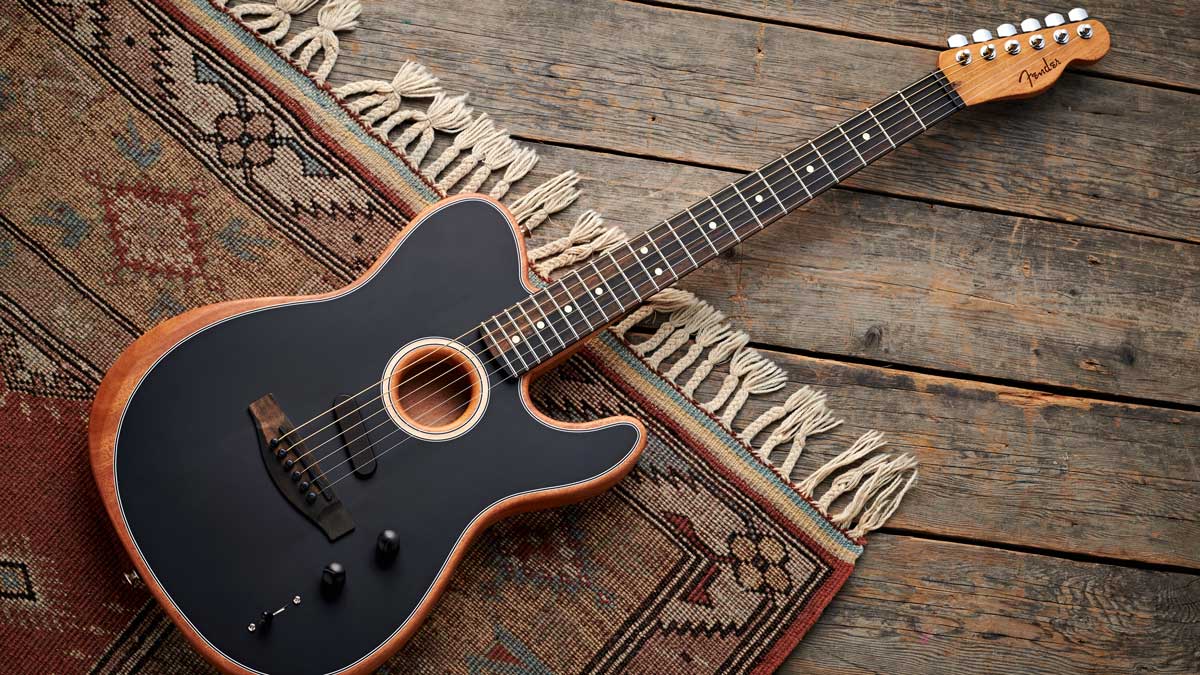
After a Tele and a Strat, the 2021 American Acoustasonic Jazzmaster model felt like the strongest hybrid suite yet; a larger body made for a slightly bigger unplugged sound and the Tim Shaw-designed Shawbucker brought a distinct flavour to a palette of ten highly usable tones.
The Mexican-made Telecaster dropped the price, but some features too. For many players it was a sweet spot, all the playability and much of the build with a more streamlined control system. For others it was still too much investment at over $1,000.
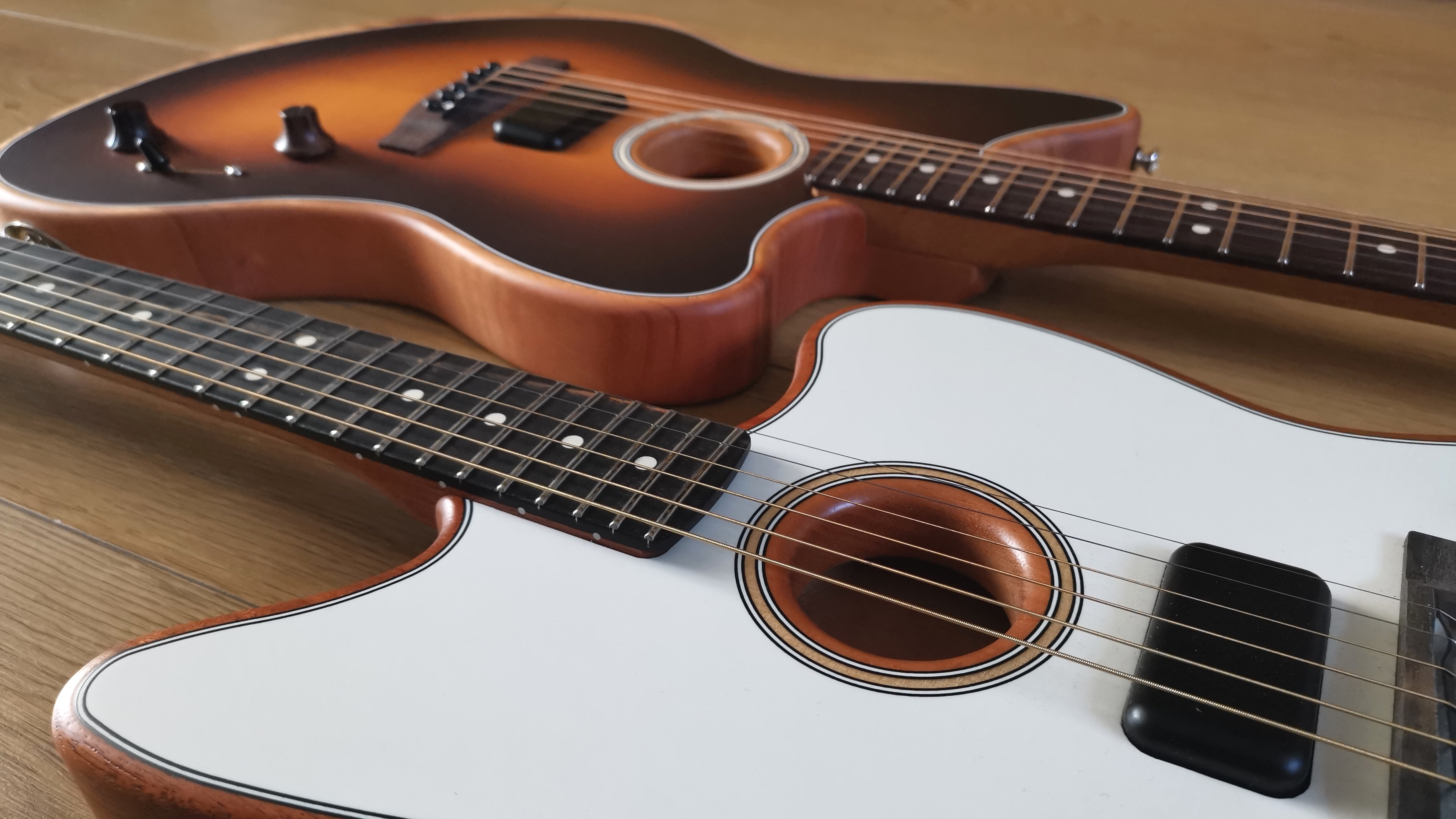
These are more involved guitars to build than much of Fender's standard factory lines, but the player proposition here is also more involved; the Acoustasonic isn't trying to be 'better' than your favourite electric or acoustic, more to give elements of both in a new combination but the familiar form of classic, beloved Fender shapes. For the asking price, how successful is this model at delivering that?
In our attempt to answer that question we have the benefit of context and comparison; we've called the American Jazzmaster model we reviewed back for duty. We'll be focussing on the differences for those players deciding on how to invest.
Want all the hottest music and gear news, reviews, deals, features and more, direct to your inbox? Sign up here.
Performance and verdict
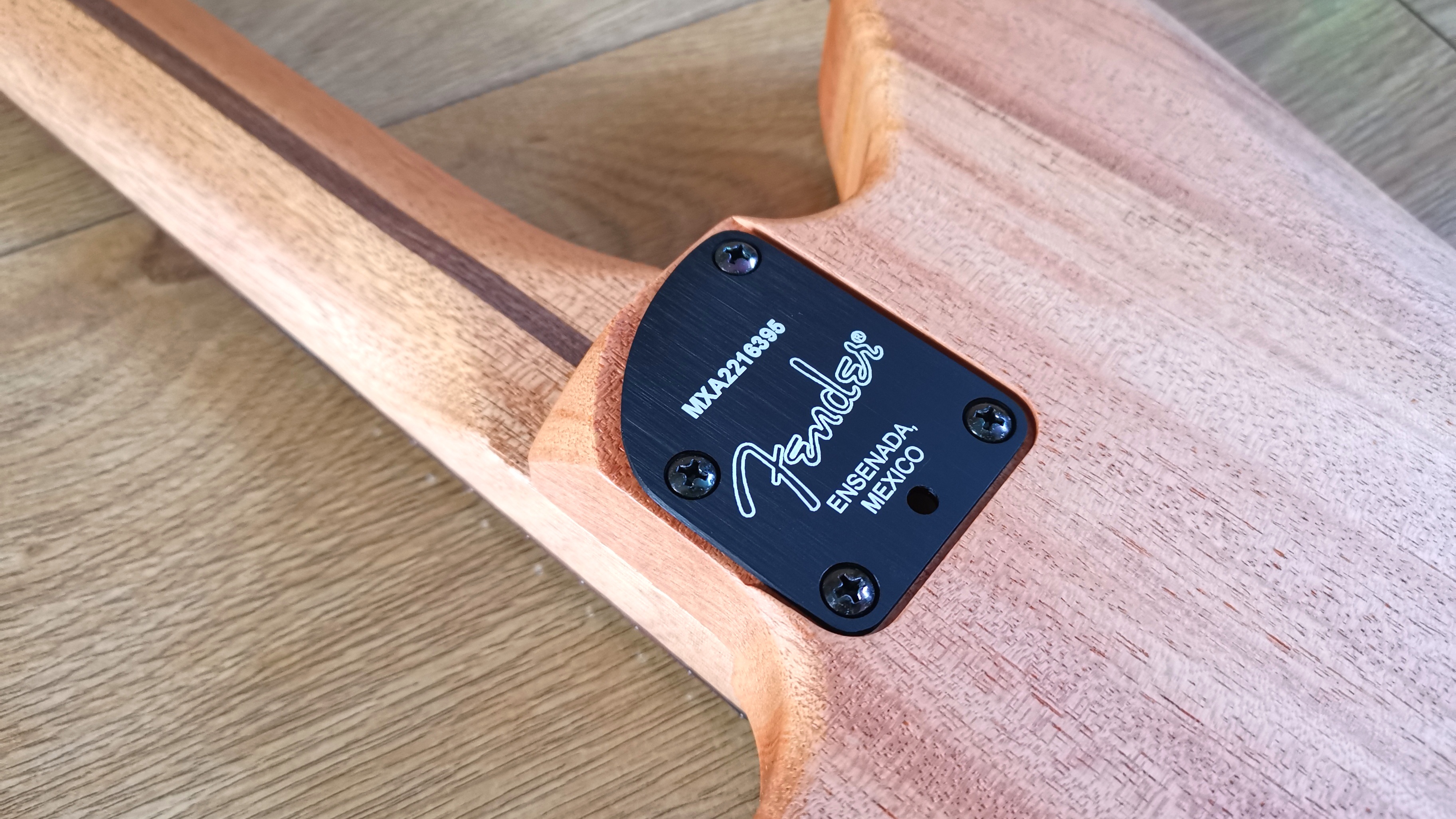
Instead of the American Jazzmaster's ebony fretboard, here we have the more uniform look of rosewood. As we discover later, the other feature differences could be more of an issue but overall the US model's darker mahogany neck and body feel smoother and more refined in direct comparison, though the Mexican model is certainly up to a high standard.
The frets are well polished on this Player model but we found a couple of high points on the fourth and fifth frets that would need levelling.
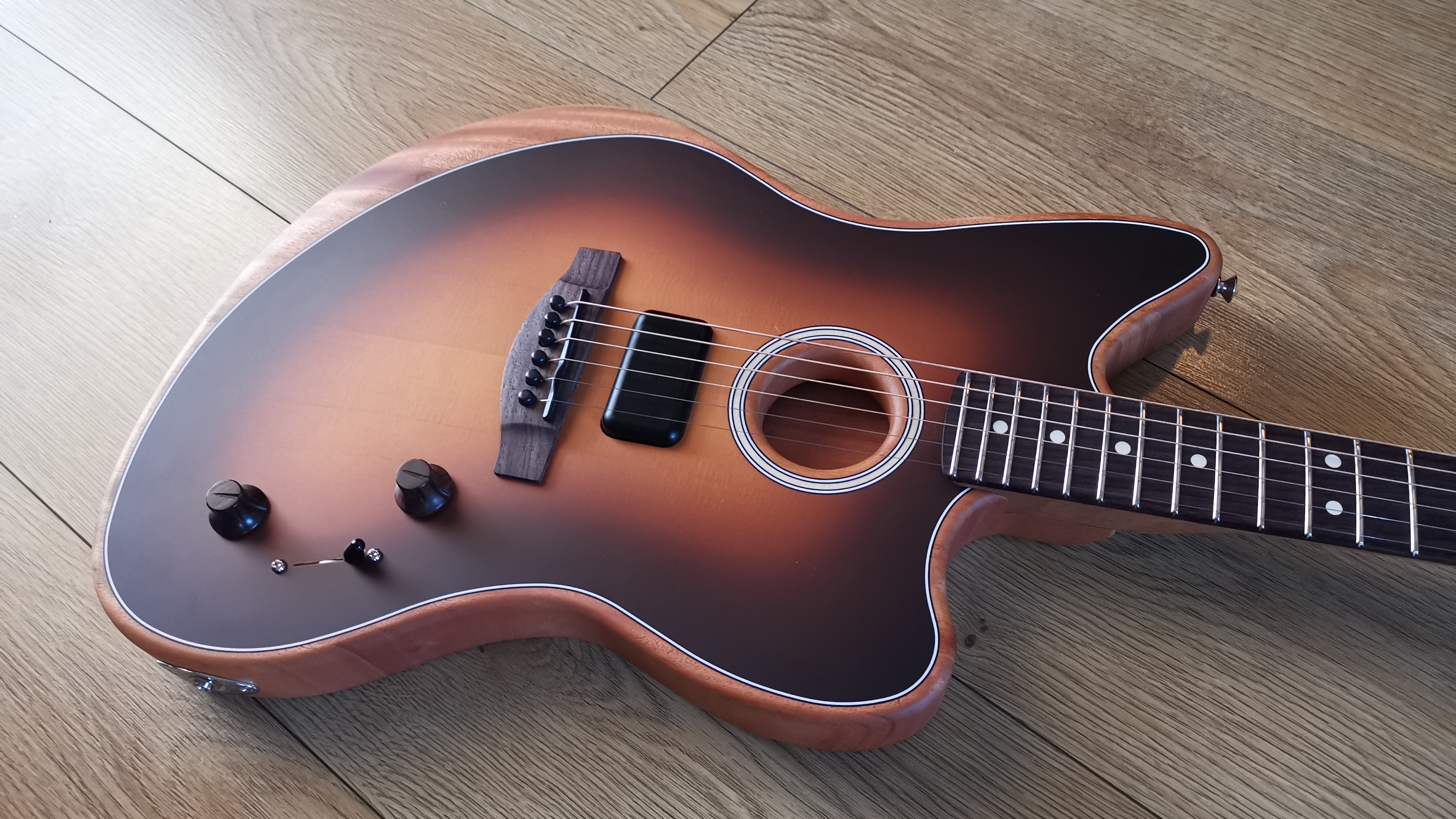
If you're used to wrestling with dreadnoughts through extended live sets, it's a bit of a revelation
All the YouTuber 'paid promotion' hype in the world can't make a guitar more playable, and the the neck here is undeniably excellent – an Acoustasonic trait. The irresistible recipe of a modern deep C (though not too deep) neck carve with just enough rustic grain texture and silky smooth satin (after our usual post-shipment trussrod tweak) is comfortable and resonant. If you're used to wrestling with dreadnoughts through extended live sets, it's a bit of a revelation. If you're an electric guitar player it's familiar, though the phosphor bronze strings here certainly ain't the slinkiness you'll be used to.
On the whole, the feel of his neck with its natural character is addictive and persuasive. It reminds us of a Trussart Rusty Steelcaster we once tried and still pine for. Oh the memories…
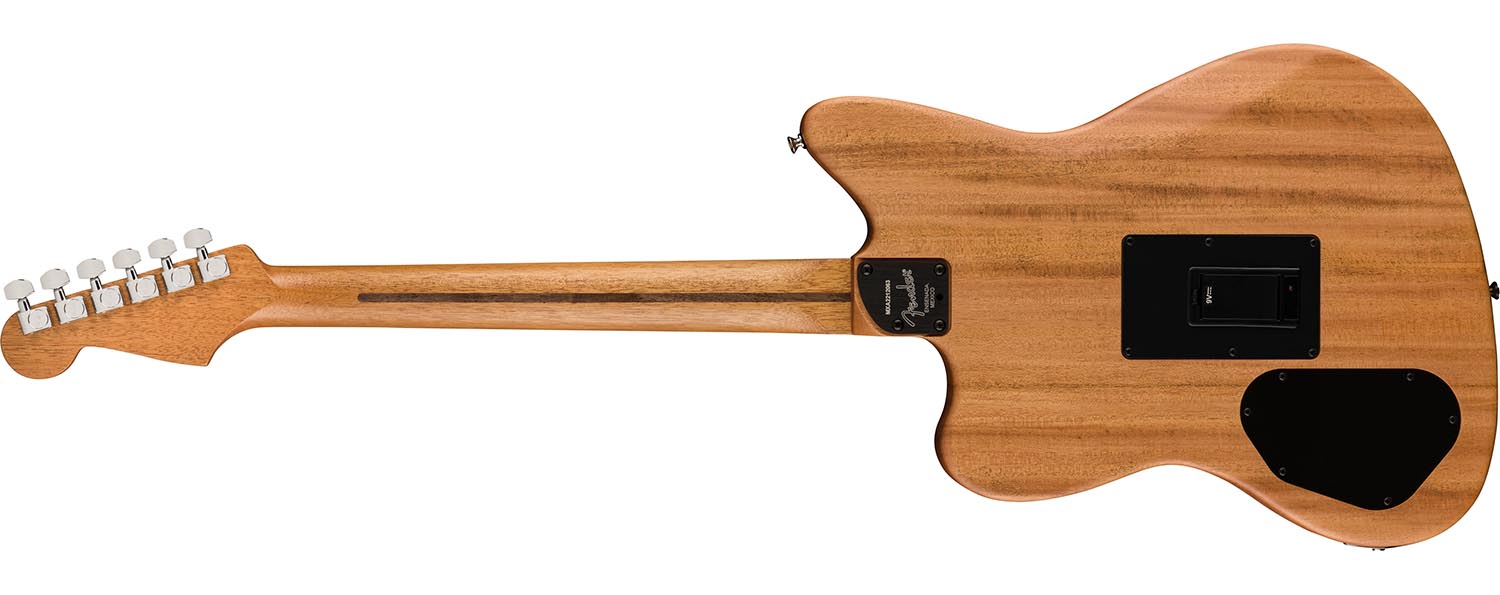
We weren't too keen on the Arctic White top finish of the American Jazzmaster when we reviewed it, and this 2-Colour Sunburst is a much more tasteful pitch to blend with the mahogany armrest bevel – still a great feature for picking comfort that we'd like to see on a few Fender electric guitar models. The other finishes available are bolder and are likewise distinct to this model; Antique Olive, Ice Blue and Shell Pink.
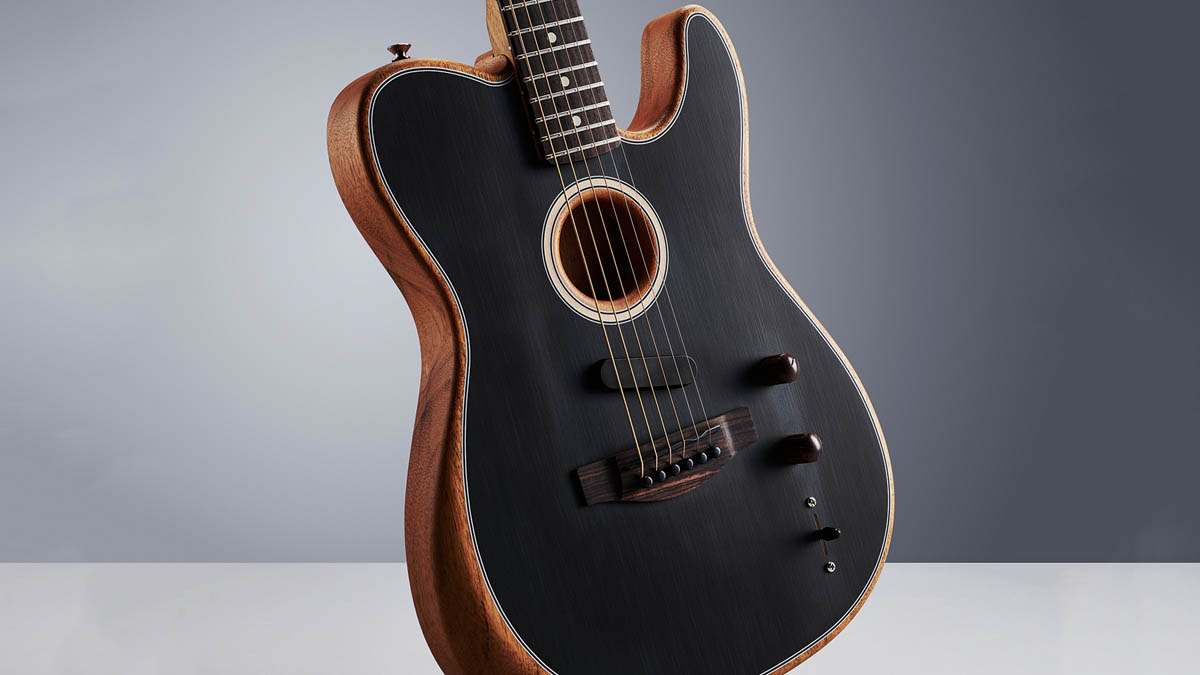
• Fender Acoustasonic Player Telecaster
This offers a Noiseless Tele pickup with position three sounds based on a Mahogany Small Body Short Scale and Rosewood Dreadnought
• Fender American Acoustasonic Jazzmaster
The US-made model features an ebony fretboard and ten different voices via a five-position switch – including a third pickup source, a body sensor.
• Córdoba Stage
An electric nylon-string guitar with a neck to attract electric guitar players. The plugged-in options make it ideal for not only classical and latin, but jazz. Plus a body sensor for percussion-style guitarists.
The Strat, Tele and Jazzmaster Acoustasonics do not bear too much scrutiny to their traditional electric guitar equivalence in terms of electric tone chracter – and that's especially true of the Shawbucker – but the shapes do impact the playing experience. A Jazzmaster places the neck further forward and encourages high fret exploration. The effect of this becomes apparent before even plugging in, and again highlights a huge strength of all the Acoustastonic guitars for us.
They're great house guitars; and as most of us do most of our playing at home that's a big deal. The Jazzmaster Acoustasonics are slightly louder acoustically than their hollow brethren, but they won't be giving even your parlour flat top sleepless nights. Don't expect a big bottom end from a guitar with a body that's only 46mm deep but we happily sung with it at home, and it projects more acoustically, though is more compressed, than the US model we have to compare. Clearly Fender's SIRS (Stringed Instrument Resonance System) waterfall soundhole is no mere gimmick and genuinely enhances the unplugged response.
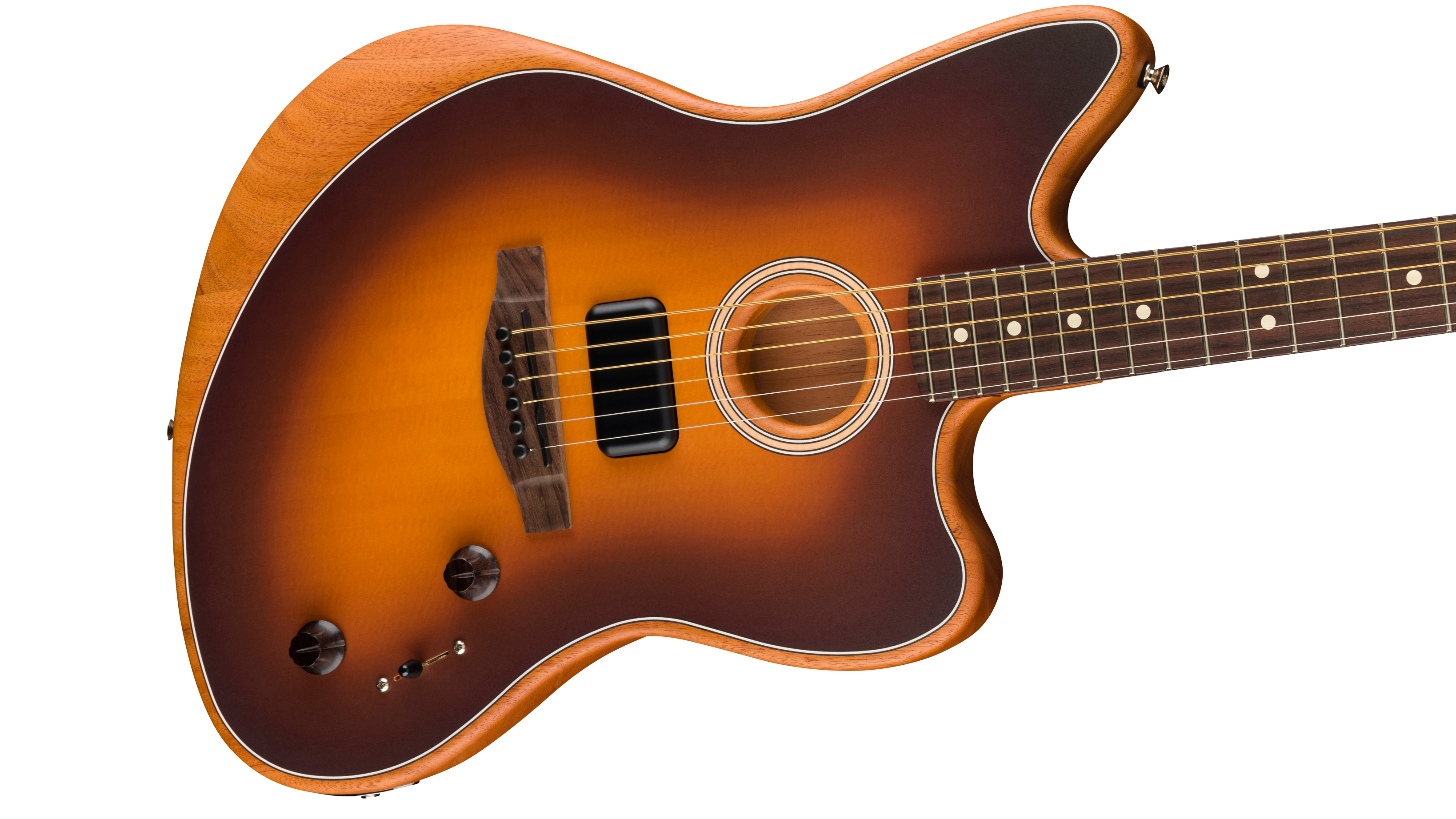
It's ideal for playing alone; articulate with a boxy mid-driven character that is really satisfying for working on ideas and practicing parts. We actually found ourselves inspired to write more, coming up with ideas out of our usual acoustic fretboard comfort zones – aided by that Jazzmaster neck placement and excellent higher 'board playability that the Micro-Tilt system allows you to tweak (see boxout).
Across the neck, notes sound clear and the relatively low action we have sees us playing things we simply wouldn't even attempt on our own Sigma dreadnought or Taylor GS Mini. This thing is addictive to have around. But how does the Player spec pan out when we're plugging in?
It's important to highlight that, just like the Player Tele version, you're getting less sounds and variation between them than the American Acoustastonic Jazzmaster
One marketing pitch of the first Mexican-made Acoustasonic model was the streamlined move from a five- to three-position pickup selector switch. But just as it can be argued to be more 'player friendly' and easier to use, it's important to highlight that, just like the Player Tele version, you're getting less sounds and variation between them than the American Acoustastonic Jazzmaster.
The body sensor has been dropped – assumingly for cost reasons – and with it the move from ten to six 'voices' that are paired in twos and can be explored with the Blend knob. Did any of us really need ten different sounds to begin with? Well, there's an argument there but we'll be honest, we especially miss that body sensor. And we'll explain why.
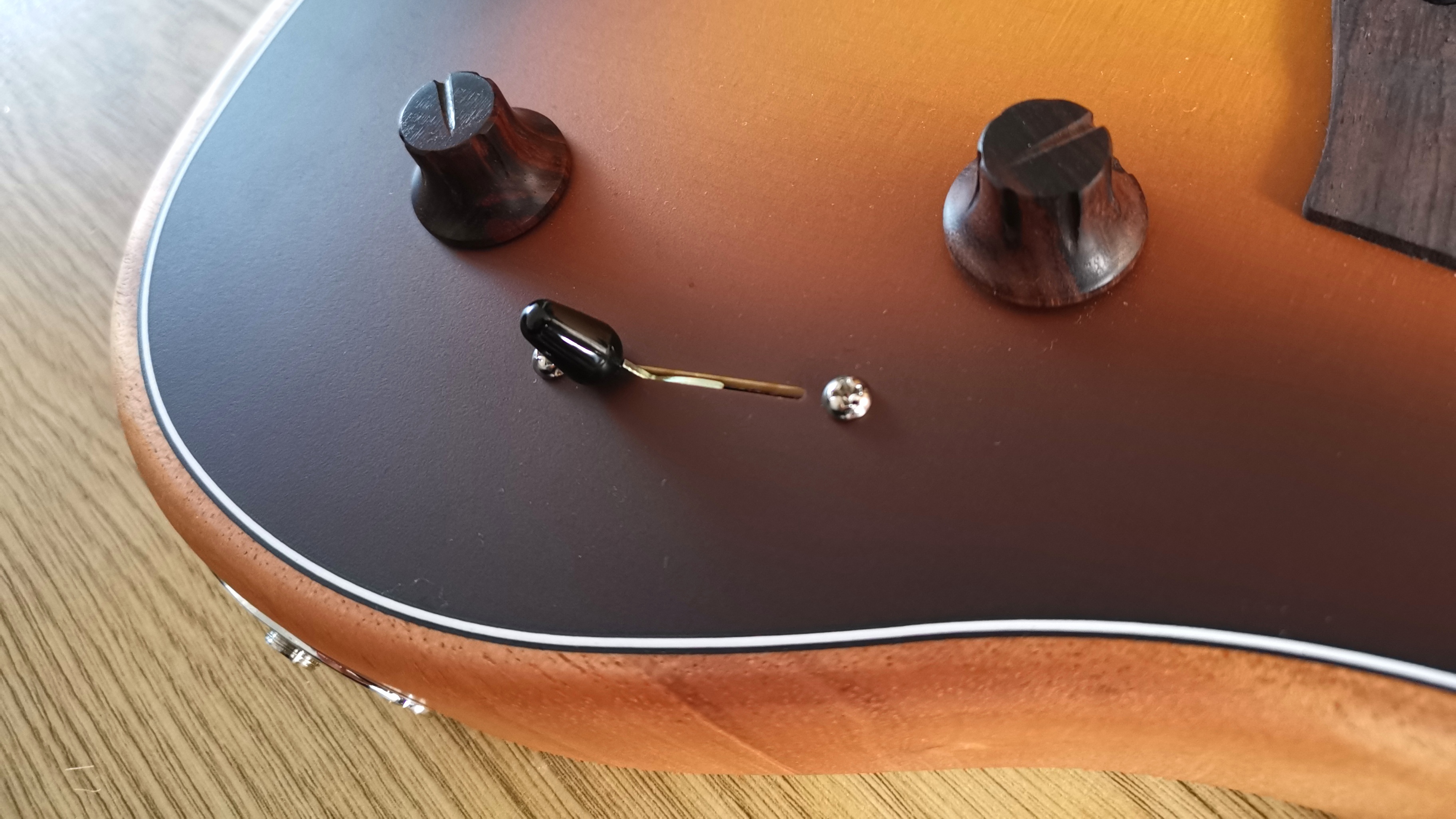
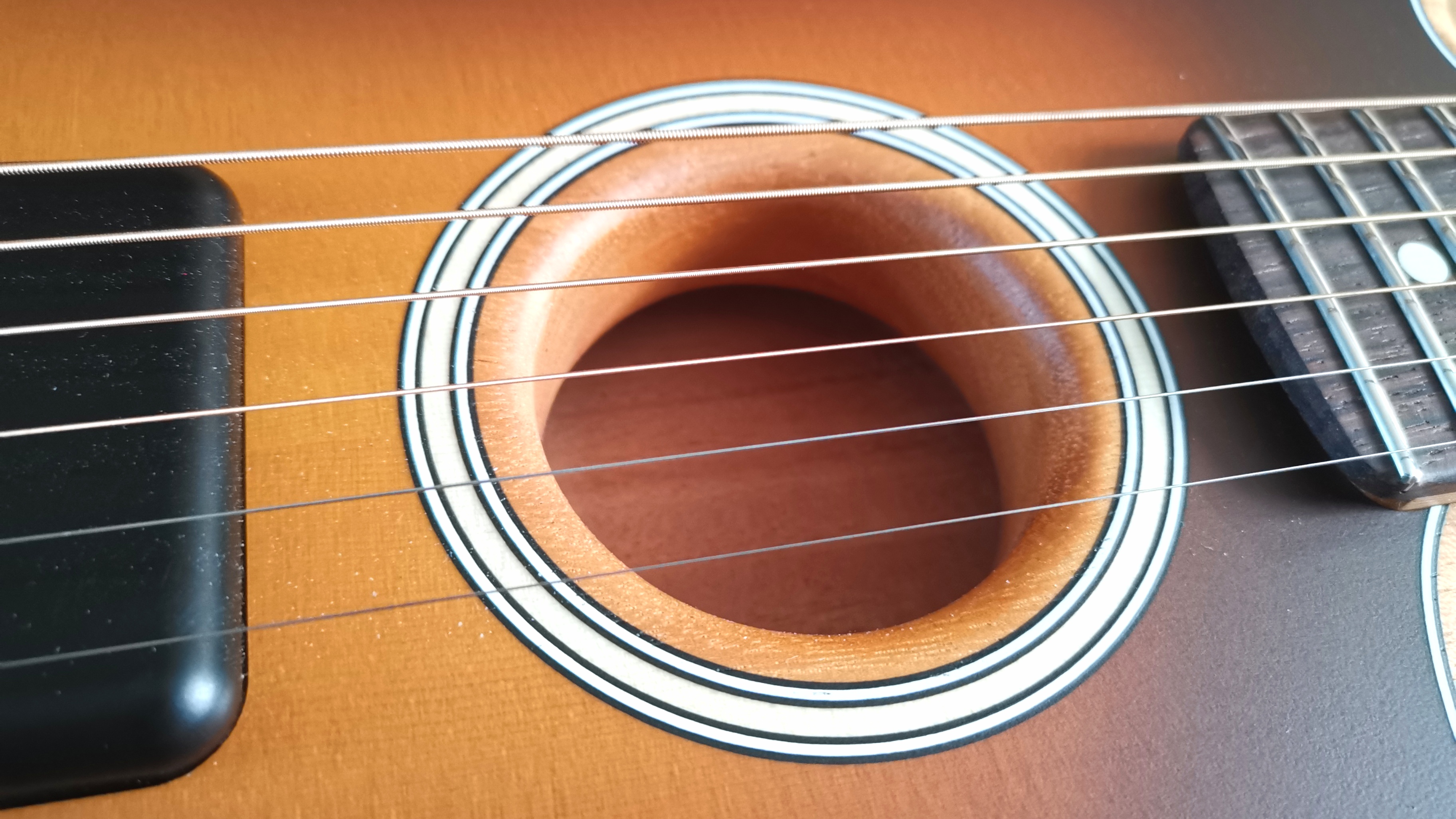
The Acoustasonic Player Jazzmaster ships with Fender's Dura-Tone 860CL Coated Phosphor Bronze in a 011-.052 gauge set. We're not convinced from the amount of string noise we experienced that they're the optimum coated choice for players and we'd recommend experimenting. The wound G here might also pose challenges for players with bending.
We would stick with an acoustic set though. Electric guitar strings will improve the response and articulation with the Shawbucker but you'll lose tonal quality with the acoustic modes – surely the principal draw here.
An 11 gauge set feels about right for us in standard tuning coming from acoustics fitted with lighter gauge strings, but electric players may prefer 10s. If you're tuning down a heavier set might pay dividends too.
You can't intonate the strings on an Acoustasonic, as it has an acoustic bridge, but you can adjust the truss rod to account for changes in tension due to string changes.
The same allen key wrench Fender provides for that can also be used to for the Micro-Tilt feature on the neck plate; it adjusts the angle of the neck in relation to the body, should that become an issue. The neck screws would need to be loosened slightly before any adjustment with Micro-Tilt.
If you're playing acoustic alone plugged in, the nuances a body sensor can provide when mixed with the articulated attack with a piezo undersaddle pickup can provide a crucial depth to the sound that offers a sense of 'realness'. In a band mix it's less of an issue because it's the kind of lower end detail that gets steamrolled by the other instruments, but for a solo acoustic performer – and especially a percussive one who needs that body sensor for that physical dynamic – it could be very important.
It's easy to say that's what accounts for the price difference here, and the American model had the added attraction of being able to blend its body sensor with the acoustic sound of an Auditorium-style acoustic.
With this Player model we have three pickup positions using two pickup sources – it's a version of what Fender calls its Acoustic Engine, designed with Fishman. There's a magnetic Fender Shawbucker pickup with clean and overdriven voices via active circuitry and a Fishman Matrix piezo with the same combo.
In the third position there's the option of combining the piezo with the kind of 'imaging' technology that Fishman has long developed in its Aura pedals and preamp systems. Think of it as a kind of mic'd acoustic IR taken from specific types of instrument – ready-mixed here with the signal from the piezo. For this guitar the images that can be blended are a smaller rosewood concert body and the broader low end of a mahogany dreadnought.
Position two's piezo without imaging are the least essential of the three positions for us
Position two's piezo without imaging are the least essential of the three positions for us; the kind of brasher undersaddle tones electro-acoustic players might be trying to get away from. It has its uses though – and can cut through for more driven parts or when its edges are softened and textured with external effects.
If you're a player that loops, the clean to 'lo-fi' driven tones here activated with the Blend knob in position two could be a useful palette to call upon for layering, but at around 50% Blend often come across as sitar-like. That's quite fun but in comparison we could live without them to be honest. We would have preferred either additional acoustic image options (including perhaps a rosewood dreadnought or jumbo) or the option for a mix between the acoustic and clean Shawbucker tones that could be varied with the Blend control.
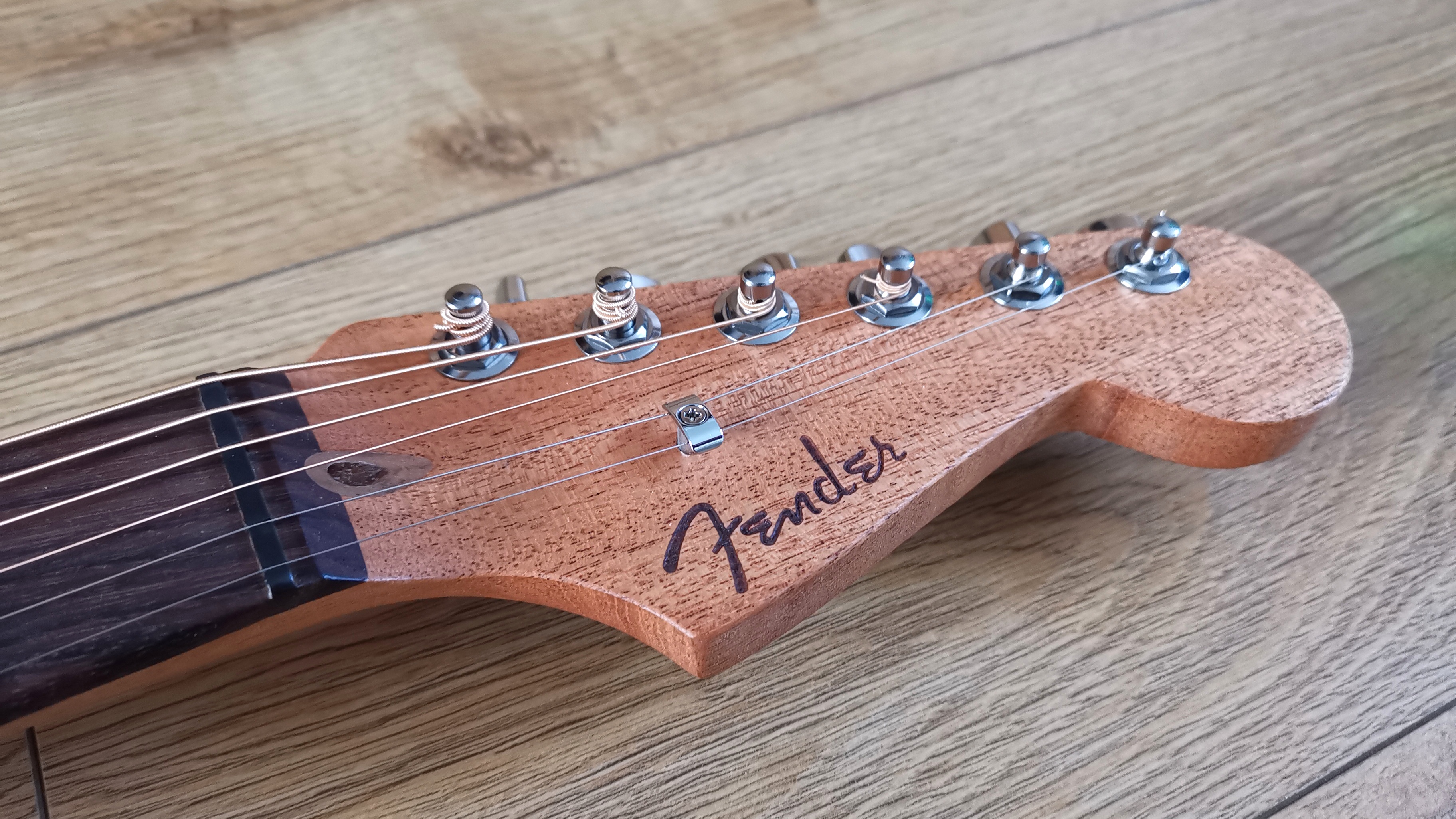
We found the main appeal here was switching between the Shawbucker's Clean and High Gain voices in position one to those acoustic images in position three. The relationship and blends of these voices is the crucial factor in whether you will bond with an Acoustasonic, and they need time to set up with your backline rig.
Think of the positions one and two as having onboard drive that you dial in with the Blend knob. That's not the kind of thing us electric guitarists are used to is it. And exploring this side of things, and stacking gain with it, is important if you're a gigging player because we found that was much more successful way of adding gain to the Shawbucker at live volume than some of the overdrive pedals we tried. Because they tended to send us on a way way trip to feedback city.
Amplifying acoustic guitars has never been a stroll down easy street for performers
It's tempting to say the Acoustasonic poses a quandary to anyone that buys it; the electric sounds will sound better through a guitar amp, while acoustic tones in positions two and three will sound superior through a PA or acoustic combo. Splitting the signal won't appeal to everyone, and there's no dual outputs here like on some piezo-loaded electric guitars, but given a good clean amp like the Fender Deluxe Reverb and our comparisons with our Laney A1+ acoustic combo, we think it's good to use for the combinations of its tones through a guitar amp with a clean channel that offers decent headroom with minimum gain.
We have to stress that amplifying acoustic guitars has never been a stroll down easy street for performers; there's variables that will be at play including preamps, compression, EQ and speakers for musicians that want to gig with these guitars. If you can try an Acoustasonic in a shop with the closest tube amp or amp pedal to your own it will help you avoid frustration or disappointment. This is where multi-effects pedals with amp modellers could pay dividends – they allow you to try combinations and save a preset.
We were really pleased with the dynamics and lack of unwelcome piezo 'quack' from the concert and dreadnought imaging in position three compared to our mahogany dreadnought electro-acoustic with a Fishman Sonitone. What it lacks in the warmth and a sense of depth that the body sensor voices on the American model offer, it makes up for in being a very usable and pleasing acoustic tone for a band mix. Of course it should for the asking price here, but we think this kind of imaging with a piezo signal is an excellent solution to the electro-acoustic tone quandary.
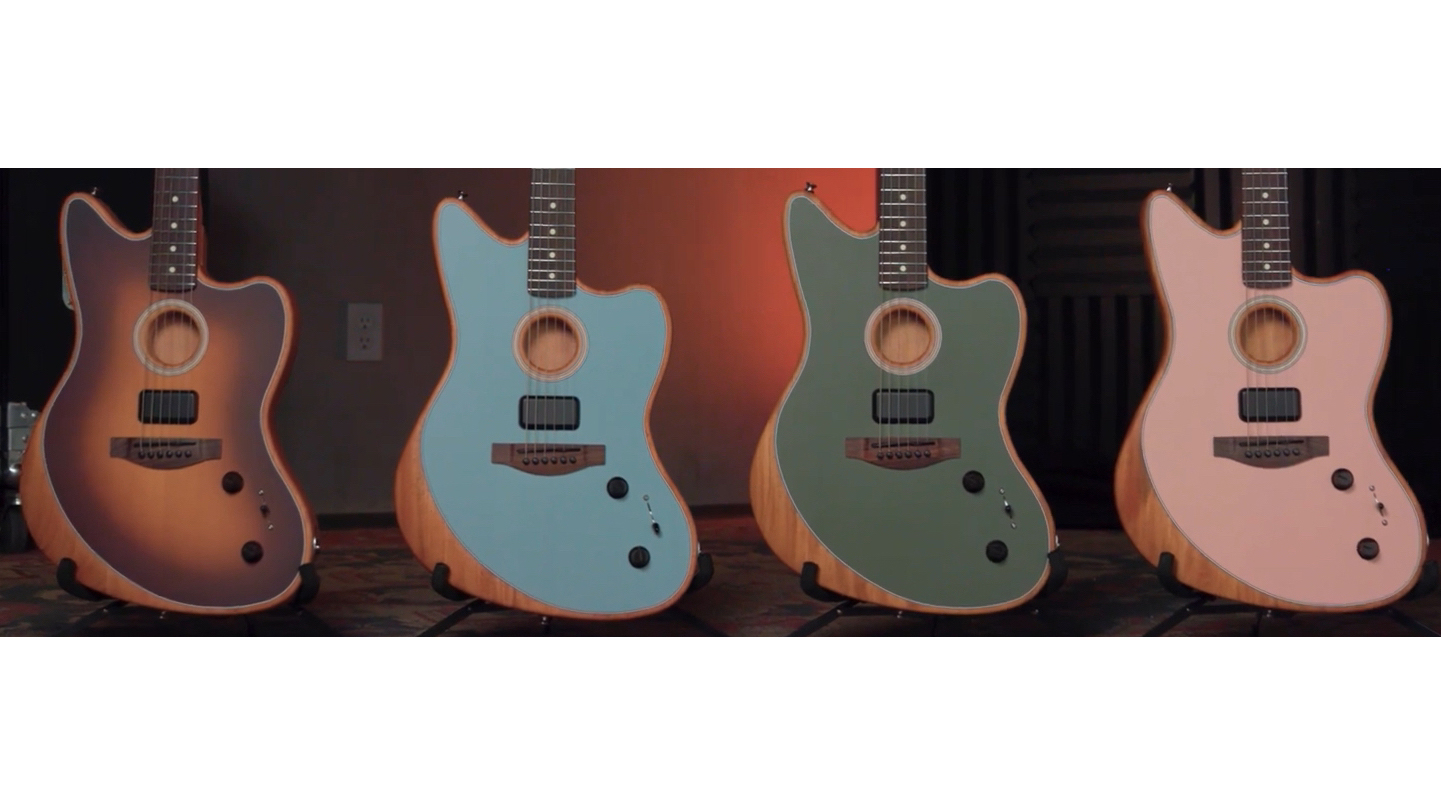
In isolation through headphones and Universal Audio's excellent Dream '65 Reverb amp emulator pedal (essentially a Deluxe Reverb we can monitor and record direct with while trying a selection of speaker emulations), the differences between the sonic package offered by the American Acoustasonic Jazzmaster we reviewed and this Player model become more apparent.
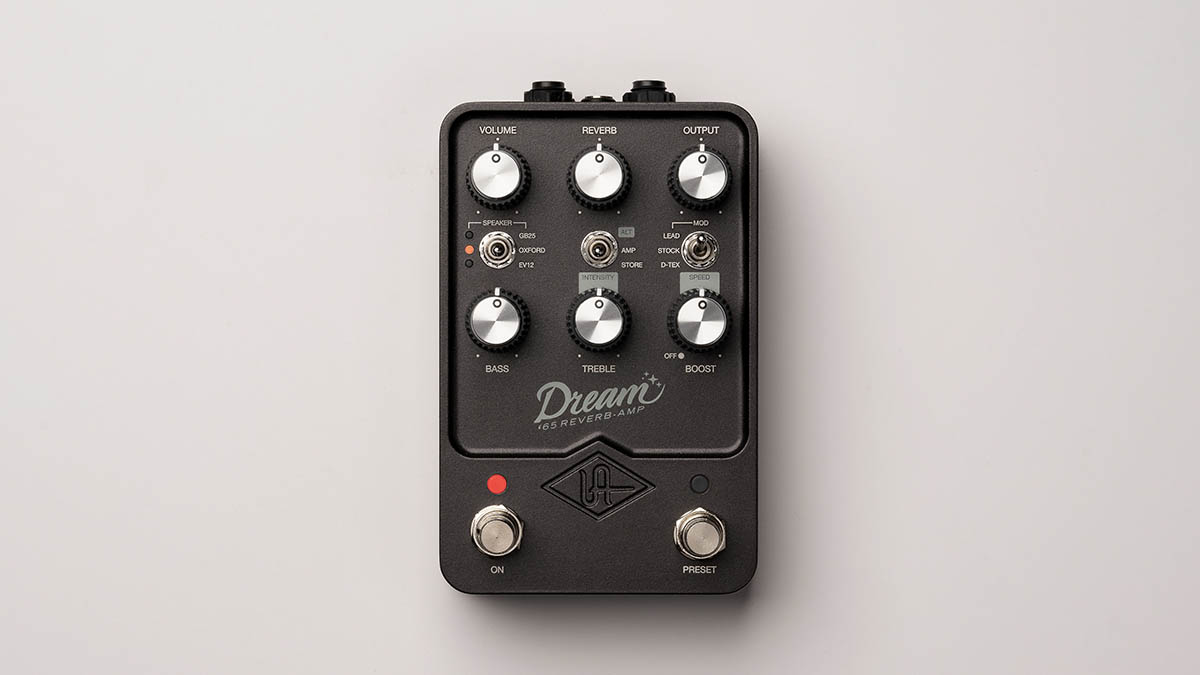
With the luxury of being able to A/B two examples where they cross over (the Acoustasonic Player has no body sensor-based voices) we found the Fishman 'imaging' less compressed in the US-made Jazzmaster
With the luxury of being able to A/B two examples where they cross over (the Acoustasonic Player has no body sensor-based voices) we found the Fishman 'imaging' less compressed in the US-made Jazzmaster. It's mellower, more refined – with less of the sense it's based on the harder edges of a piezo sound. The Player Jazzmaster's acoustic voices are hotter compared.
There is no competition for recording an acoustic guitar with a condenser mic but sometimes – and this writer lives in a house with his two young children – that's not always possible for practical reasons. For recording into a DAW via the UA Dream '65 (using its onboard spring reverb) we found that the American Acoustasonic Jazzmaster was again superior for us because the piezo basis of the acoustic voices was less compressed to our ears, especially with the body sensor options for strumming that soften the edge of a piezo-based source. So yes, the price difference does count here.
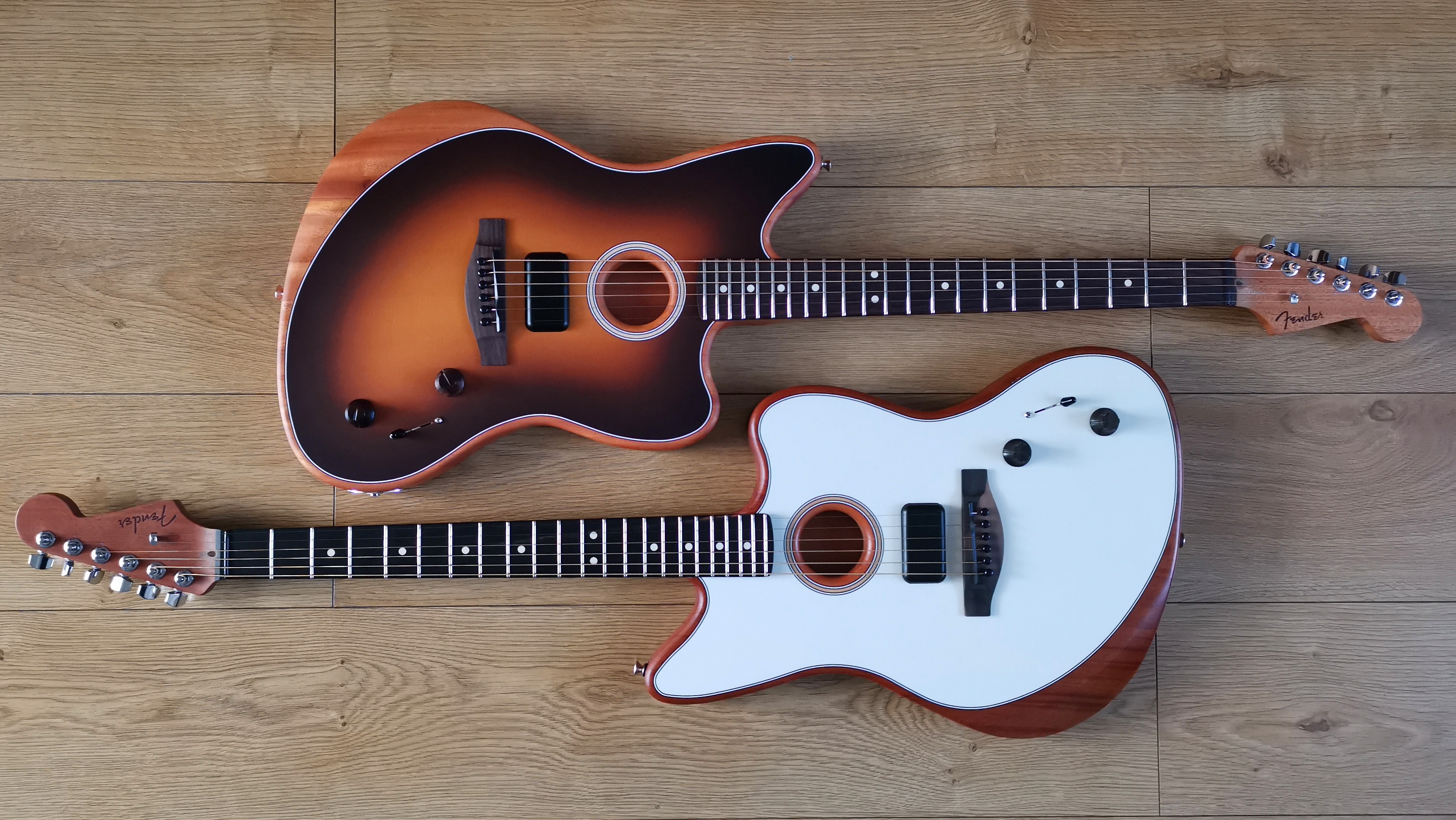
We think one of the main ways people will use the Player model will be switching between the acoustic imaging / piezo mix and the Shawbucker
We think one of the main ways people will use the Player model will be switching between the acoustic imaging / piezo mix of position three and the Shawbucker. It's quite a dynamic change and a big part of the Acoustasonic appeal, but we noticed it was less of an abrupt one with the American model because the levels between the voices felt more balanced. Again, what sounds to us like a hotter piezo may be the source of the difference and with the Player model we felt we needed to dial back the volume control on the acoustic voices so we could keep some level to dial in when switching to the Shawbucker sounds. It certainly made the hybrid switching concept here less seamless on our specific test guitar.
As for the Shawbucker itself, it offers a usable electric tone for parts. Would it replace an electric guitar for all your needs? No, the nature of bronze acoustic guitar strings, tension and a hollow body makes for a different response (see boxout) but as Kirk Hammett proved with Metallica in the live video above, the Shawbucker is a great way to introduce a kind of humbucker tone into an acoustic context. Take the time to find the right ways to dial in the onboard gain with the Blend control and you have two very different sounds to switch between, with the variations in between.
Powering all this active circuitry is a 9-volt battery that's easily accessible at the rear of the body in its own compartment. This is instead of the American Jazzmaster's rechargeable lithium power source. The former more old school approach is much preferable to us as it's great for swapping out as and when needed, and sidesteps the risk of an internal, non user replaceable lithium battery degrading over time. More importantly, it's less of a risk at gigs.
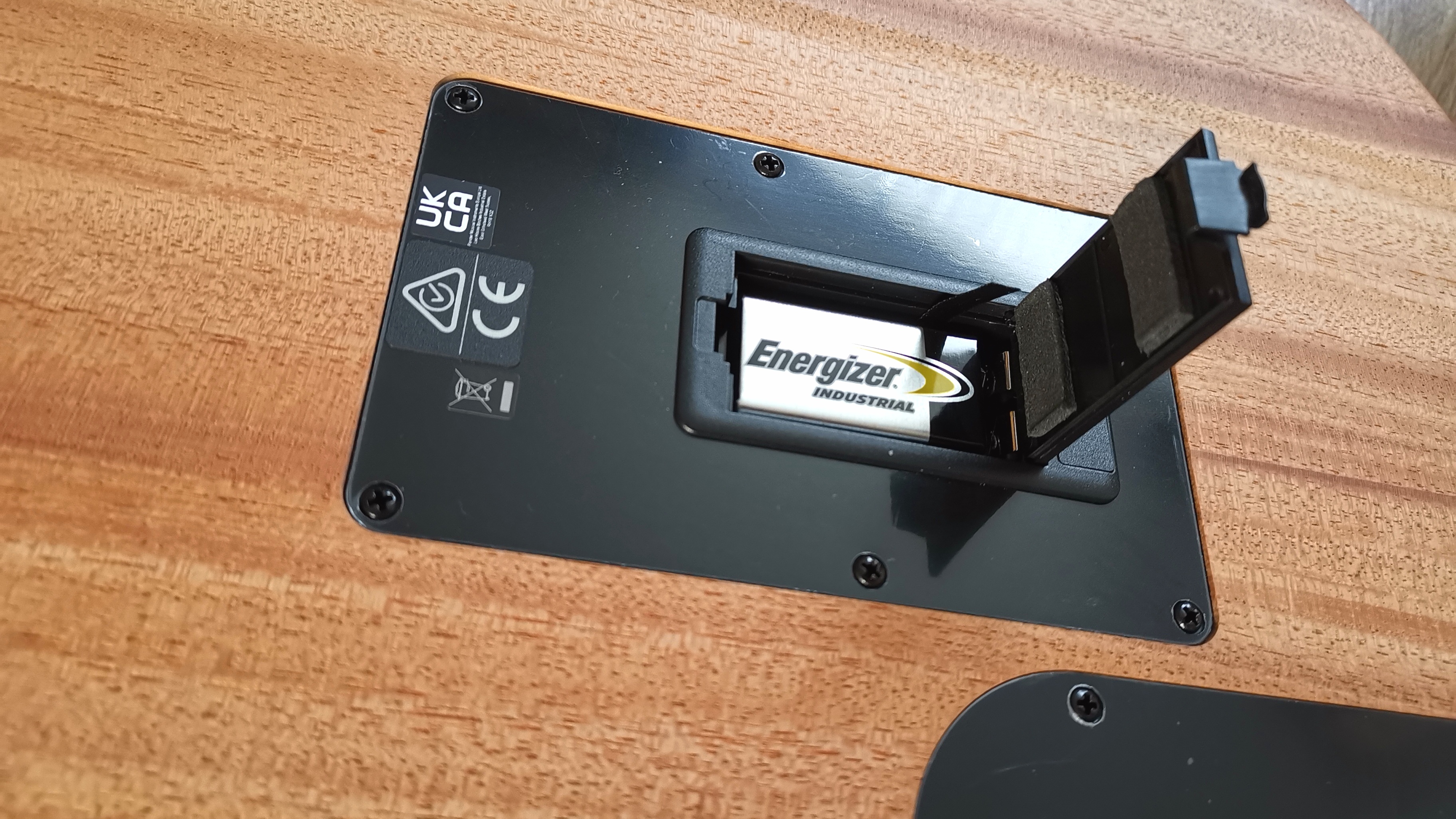
The maximum battery life of 22 hours is understandable when you consider the onboard drive for the active pickup circuitry, as well as the acoustic imaging. We'd advise you to carry a spare because this guitar will not work plugged in without battery power. There's rechargeable options on the market too. So we'd say that this is one area where the Mexican-made model has the edge on the more expensive American one for gigging guitarists.
Is the Acoustasonic Jazzmaster Player a different kind of electro-acoustic guitar, rather than an electric with acoustic voices?
Is the Acoustasonic Jazzmaster Player a different kind of electro-acoustic guitar, rather than an electric with acoustic voices? We think it's kind of its own thing, a hybrid that leans more towards acoustic appeal, and approaching it as a do-it-all solution to excel in all fields may leave you feeling disappointed.
It's a really useful option for solo performers who need to move quickly between voices, but for us it could also be a great second acoustic muse alongside your main electric, and your go-to guitar to grab at home. It will shine in an electric rig with the right consideration and is a fine guitar for solo artist gigs with pedals. And the excellent F1225 semi-rigid gigbag it comes with is definitely ready for the road – significantly better quality than the cases currently offered with other, admittedly cheaper, Player series Mexican electric guitars.
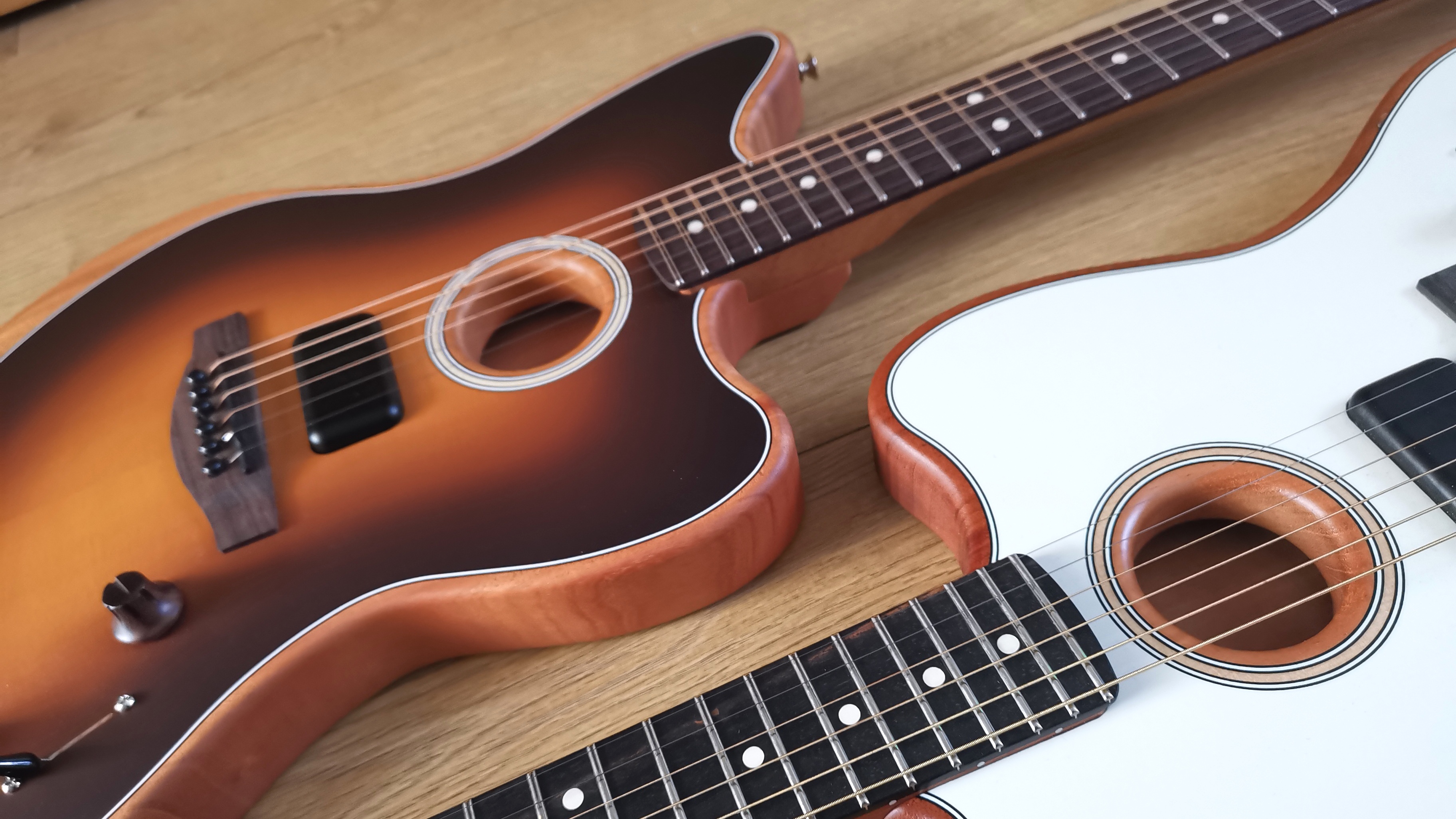
In all this talk of spec, the enjoyment of playing is something we're reminded of whenever we try an Acoustasonic guitar
Moreover, having these guitars around for reviews has revealed them as inspiring instruments to keep close for songwriting and just the simple joy of playing guitar. In all this talk of spec, the enjoyment of playing is something we're reminded of whenever we try an Acoustasonic guitar. Kudos to Fender for that, and taking some bold steps in new areas with this series.
This guitar is moreish for late night playing without the need to plug into an amp, while keeping the volume relatively intimate but highly responsive. There's a lot to be said for a guitar that plays so well, and keeps you coming back for more – especially if it opens up a new set of tones in your rig.
Like the Player Tele version, this Acoustasonic offers a distinct choice. Internal rechargeable battery aside, the American model we had to compare is the better instrument. We found a superior balance between its voices, and the Fishman Acoustasonic Enhancer top sensor's absence is a feature that has been seemingly dismissed elsewhere, but we think it's potentially a far bigger deal for those investing. It being superior isn't really a surprising revelation of course, and in an ideal world we'd choose the American model's bells and whistles (with replaceable batteries).
Is that worth around $600 difference in street price for a guitar purchase that could be a step into the unknown for many? It really depends on how deep your need to mine the acoustic sounds is here, because the build quality is high here and you still get a Jazzmaster's larger body for top resonance. Along with some excellent tones of course. For many electric players attracted to this as their acoustic fix, the price difference won't be justified. But we urge you to try both because the body sensor does make for more authentically acoustic sounds.
An equally pertinent question is where the Acoustasonic series goes from here in bringing more players onboard. Fender CEO Andy Mooney has confirmed to us that an Asian-built model is coming. Whether that will be under the Squier banner remains to be seen, but we're intrigued to see what build compromises will have to be made to deliver an even lower price point. As it stands, this Ensenada factory-built Acoustasonic sets a high standard to measure whatever comes next by.
MusicRadar verdict: The Acoustasonic format remains an appealing and addictive instrument to have around. The standard here is high enough that players will mainly need to decide if the loss of the American model's body sensor and the tones it offers is worth the price difference for their needs.
Specifications
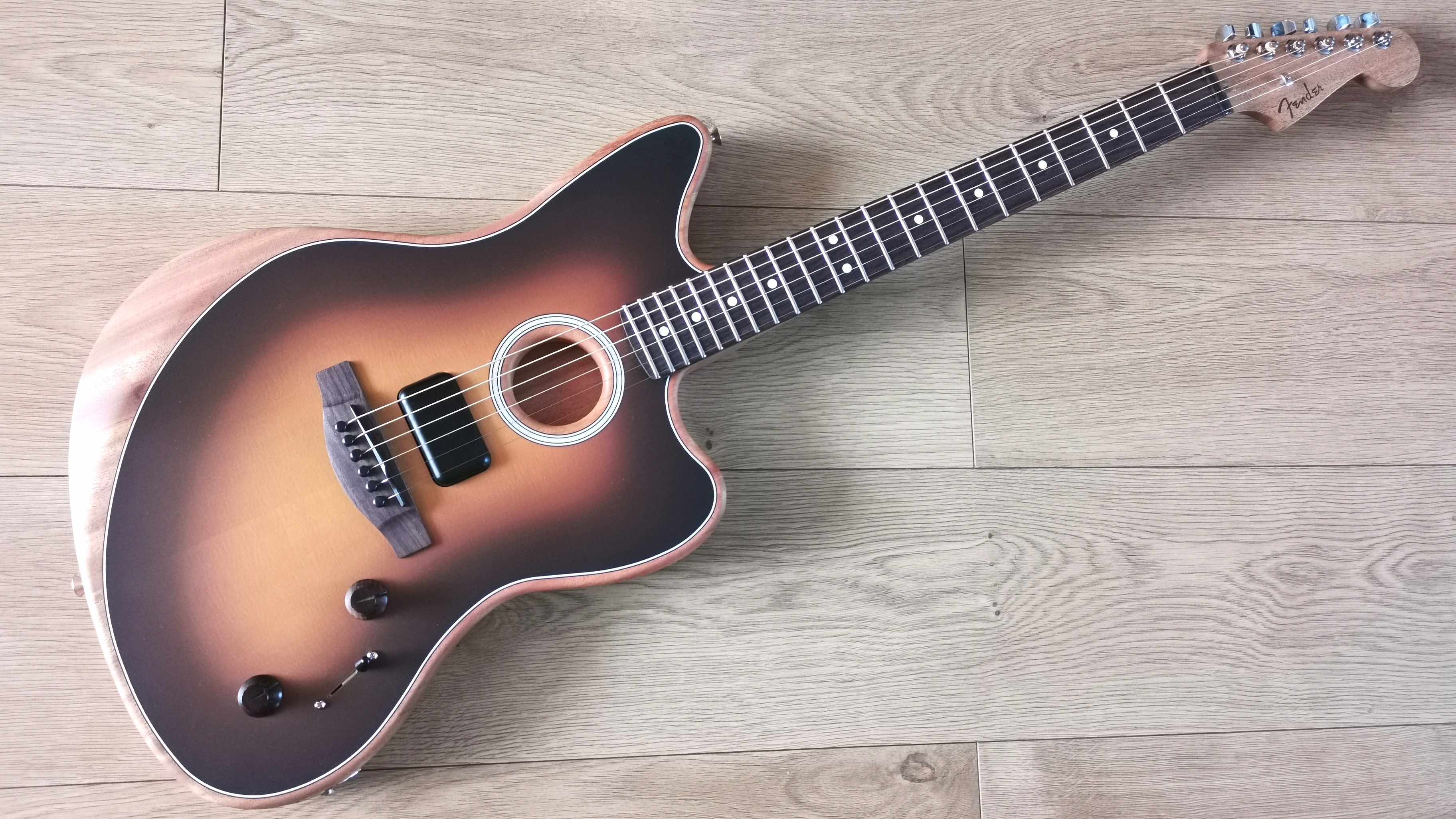
- PRICE: £999 (with semi-rigid gigbag)
- ORIGIN: Mexico
- TYPE: Double-cutaway, solidbody-sized electro-acoustic
- BODY: Mahogany (hollow)
- NECK: Mahogany, Modern Deep 'C', satin urethane finish
- SCALE LENGTH: 648mm (25.5”)
- NUT/WIDTH: Graph Tech Black Tusq/42.8mm
- FINGERBOARD: Rosewood, 12" radius
- FRETS: 22, Narrow Tall
- TUNERS: Fender Standard cast/sealed chrome tuners,
- STRING SPACING, BRIDGE: 52mm
- ELECTRICS: Two-pickup configuration: Fishman under-saddle transducer, Fender Acoustasonic Shawbucker, master volume, Blend knob, three-way Voice Selector lever switch. Single mono output. Nine-volt battery power (up to 22 hours battery life).
- WEIGHT (kg/lb): 2.6/5.8
- LEFT-HANDERS: No
- FINISHES: Ice Blue, Antique Olive, Shell Pink, 2-Colour Sunburst (as reviewed)
- CONTACT: Fender

Rob is the Reviews Editor for GuitarWorld.com and MusicRadar guitars, so spends most of his waking hours (and beyond) thinking about and trying the latest gear while making sure our reviews team is giving you thorough and honest tests of it. He's worked for guitar mags and sites as a writer and editor for nearly 20 years but still winces at the thought of restringing anything with a Floyd Rose.
